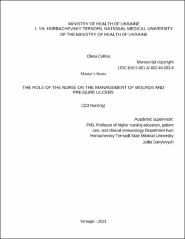| dc.description.abstract | A pressure ulcer is localized injury to the skin or underlying tissue, usually over a bony prominence, as a result of unrelieved pressure. Predisposing factors are classified as intrinsic or extrinsic. Prevention includes identifying at-risk persons and implementing specific prevention measures, such as following a patient repositioning schedule; keeping the head of the bed at the lowest safe elevation to prevent shear; using pressure-reducing surfaces; and assessing nutrition and providing supplementation, if needed. When an ulcer occurs, documentation of each ulcer (i.e., size, location, eschar and granulation tissue, exudate, odor, sinus tracts, undermining, and infection) and appropriate staging are essential to the wound assessment. Treatment involves management of local and distant infections, removal of necrotic tissue, maintenance of a moist environment for wound healing, and possible surgery. Debridement is indicated when necrotic tissue is present. Urgent sharp debridement should be performed if advancing cellulitis or sepsis occurs. Mechanical, enzymatic, and autolytic debridement methods are non-urgent treatments. Wound cleansing, preferably with normal saline and appropriate dressing, is a mainstay of treatment for clean ulcers and after debridement. Bacterial load can be managed with cleansing. Typical antibiotics should be considered if there is no improvement in healing after 14 days. Systemic antibiotics are used in patients with advancing cellulitis, osteomyelitis, or systemic infection. | uk |

